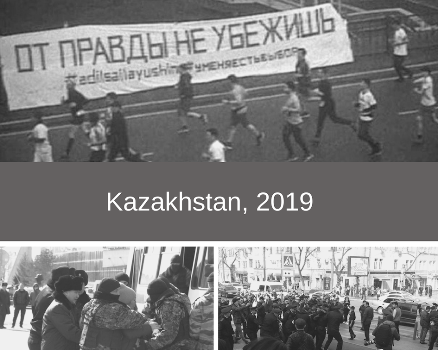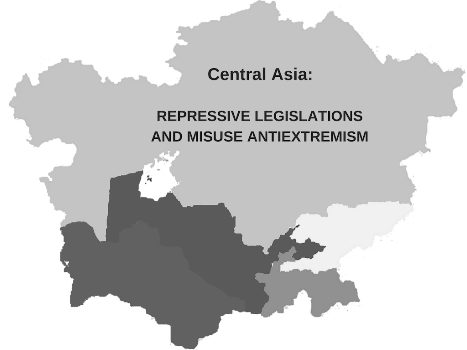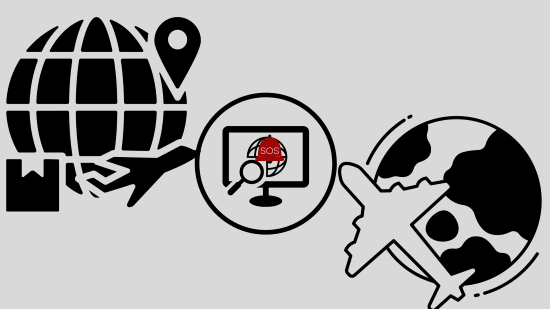6-05-2019, 00:41 Категория: English » News
Inveterate low scorers: level of the freedom of expression in Central Asian states is below 4
School of Peacemaking and Media Technology in CA published a report "FREEDOM OF EXPRESSION IN CENTRAL ASIA:TRENDS AND PECULIARITIES-2019.”
The full report in Russian is available here.
This research differs from previous ones by a wider focus on the freedom of expression, and the authors didn’t focus on the media freedom level only. Comments on own or public affairs, public opinion polls, discussion of human rights, journalism, expression of ethnic, cultural, linguistic and religious identities, creative self-expression, topics and discussions at various events and trainings are the examples of the forms of expression, so they were tested for the purpose of rankings.
The researchers prepared this index on a 5-point scale, where 5 - excellent; 4 - good; 3 - fair; 2 - poor; 1- very poor.
Turkmenistan holds the worst position in the Central Asia. Respondents and researchers summarised all data and put this country to the lowest place by giving it a 1. "1” means the legitimate freedom of expression, yet it cannot be exercised. People have no alternative sources of information, content is widely blocked, people don’t take part in political discussions because of fear of repressions[1].)
Tajikistan has 2 in the freedom of expression and follows Turkmenistan as it has blocked access to independent web sites and social media, while the level of censorship in the media remain very high. The authorities strengthen online censorship when the social and political situation in the country gets tense[2].
Despite positive changes in Uzbekistan emphasised by some international indexes, namely release of journalists who had been arrested during Karimov’s regime from prison, this country of "nominal shift of power” keeps controlling internet and censoring the users.
Somewhat more than "2” in the index means that respondents think there’s still a long way to go before the real improvement of the freedom of expression situation[3].
 A critical situation with the freedom of expression has developed in Kazakhstan; the country was given a bit above 2 in this index. On April 21, 2019, two activists – Asiya Tulesova and Beibaris Tolymbekov – were detained in Almaty for 15 days for holding a banner with a slogan "You cannot run from the truth – I have a choice”[4]. It happened during the marathon with 17 thousand participants, when the activists were holding a banner along the route and expressed their opinion that way. The sports campaign was dedicated to the presidential election to be held in Kazakhstan this June[5].
A critical situation with the freedom of expression has developed in Kazakhstan; the country was given a bit above 2 in this index. On April 21, 2019, two activists – Asiya Tulesova and Beibaris Tolymbekov – were detained in Almaty for 15 days for holding a banner with a slogan "You cannot run from the truth – I have a choice”[4]. It happened during the marathon with 17 thousand participants, when the activists were holding a banner along the route and expressed their opinion that way. The sports campaign was dedicated to the presidential election to be held in Kazakhstan this June[5].
Kyrgyzstan, which takes the highest position – 3+, and cannot reach 4, adopts the methods used in neighbouring countries to repress freedom of expression[6].
The level of the freedom of expression in Central Asia states was assessed by experts according to the following 5-point scale:
5 Freedom of expression is encouraged, democracy is thriving, lack of censorship, understandable legislation, citizens express their opinions openly.
4 Freedom of expression is encouraged, access to information is available, citizens take part in political discussions, existing legislation, yet interpretation and enforcement issues remain; improvement of the skills of media literacy, media culture and network ethics.
3 Freedom of expression is secured in legislation, access to information is partially available, information is filtered, citizens take part in political issues discussions on online platforms only, communications are not protected, content may be blocked partially to restrict the freedom of expression, users may be interrogated for their statements.
2 Freedom of expression is secured in legislation, access to information is limited via various mechanisms, including countering dissent, citizens rarely express their opinion on political issues, detentions and arrests for expression of opinions are practised.
1 Freedom of expression is secured in legislation, yet not implemented, people have no alternative sources of information, content is widely blocked, citizens don’t take part in political discussions because of fear of repressions.
Opinions of respondents about the improvement of the freedom of expression:
84% of 100% of respondents think political changes, more freedoms and media pluralism are needed;
79% of 100% are confident that the existing laws may be enforced by political will;
63% of 100% spoke about the need to change the laws and make the authorities and the society follow them;
49% of 100% think the freedom of expression will expand further without internet blocking because it has immense limits;
33% of 100% hope more on the active civil society with a sustainable stance and capacities to promote the freedom of expression;
16% of 100% said the society should seek the freedom of expression;
4% of 100% were pessimistic and said nothing could be done to change the current situation.
 One of the trends that has a negative influence on the freedom of expression in Central Asian states is the existing law enforcement practice based on wide interpretation of the incitement of hatred and hostility in local criminal statutes (1), which makes them even more dangerous. Kazakhstan is the leader in the region in the restriction of the freedom of expression by charging journalists, users and activists with the incitement of various kinds of hatred[7]. Misuse antiextremism (2) is the second trend used to restrict the freedom of expression in the majority of Central Asian states in the contexts of the above statutes. On the one hand, it is due to the vague wording of the definition of "extremism” in local laws, which is the heritage of criminal statutes of the former Soviet Union. On the other hand, Kazakhstan, Kyrgyzstan and Tajikistan, which comprise a military-political bloc, Collective Security Treaty Organisation (CSTO) supervised by Russia, use the common anti-extremist legislation, where such vague concepts enable their misuse to restrict the freedom of expression. The on-going references to the threat of extremisms/terrorism trend allow Central Asian authorities to block online resources.
One of the trends that has a negative influence on the freedom of expression in Central Asian states is the existing law enforcement practice based on wide interpretation of the incitement of hatred and hostility in local criminal statutes (1), which makes them even more dangerous. Kazakhstan is the leader in the region in the restriction of the freedom of expression by charging journalists, users and activists with the incitement of various kinds of hatred[7]. Misuse antiextremism (2) is the second trend used to restrict the freedom of expression in the majority of Central Asian states in the contexts of the above statutes. On the one hand, it is due to the vague wording of the definition of "extremism” in local laws, which is the heritage of criminal statutes of the former Soviet Union. On the other hand, Kazakhstan, Kyrgyzstan and Tajikistan, which comprise a military-political bloc, Collective Security Treaty Organisation (CSTO) supervised by Russia, use the common anti-extremist legislation, where such vague concepts enable their misuse to restrict the freedom of expression. The on-going references to the threat of extremisms/terrorism trend allow Central Asian authorities to block online resources.
The growing penetration of the internet in Central Asia, the increase in the number of users created third trend - implementation of user-generated content into professional journalism (3). And finally, researchers recorded rather high level of propaganda and hate speech (4) in the media. However, despite the fact that government propaganda is reported in media outlets of all five Central Asian states, hate speech prevails in Kyrgyzstan, to a lesser extent it exists in Kazakhstan, and is almost missing in the media outlets in other countries.
About methodology: The level of the freedom of expression was determined based on the findings of annual media monitoring for hate speech in public discourse, surveys and in-depth interviews with journalists, editors and media specialists of Kyrgyzstan, Kazakhstan, Uzbekistan, Tajikistan, Turkmenistan, and analysis of journalistic articles and user generated content based on a special scale, as well as reports about media situation. 2,189 documented media texts and visual content were analyzed in total, which were published on 79 open media resources. Also, verbal and written surveys were held and covered 500 respondents, including journalists, editors, bloggers, human rights activists of the five countries. Moreover, we used opinions of nearly 700 participants of trainings and conferences conducted by the School of Peacemaking in 2018-2019 about the current level of the freedom of expression and threats in Central Asian states. All comments were documented, processed by experts of the media monitoring application, and then systematised for the general rating. Guests of on-going open consultations on the freedom of expression and hate speech regularly held by the School of Peacemaking and Media Technology in Central Asia contributed to the rating. Their opinions were taken into account when assessing the basic level of the freedom of expression and cases of its restriction.
The freedom of expression is reviewed in the report in several aspects:
- an opportunity to seek, obtain and distribute information regardless of boundaries, including on the internet;
-the level of media pluralism, tolerance to a variety of manifestations of the freedom of expression;
-admissible criteria of the rhetoric of hate according to the local laws and contexts;
-available restrictions of the right of the freedom of expression.

Состоялась онлайн конференция, на которой обсуждались риски транснациональных репрессий в работе активистов, медиаработников, юристов и…
Можете ли вы ответить на вопрос: что такое миротворческая журналистика или журналистика мира, как это принято говорить в международной практике?
Это – позитивная журналистика?
Это – смягчение конфликта за счет историй, где говорится о том, как власти решают проблему?
Или это – баланс фактов и мнений, построенных на беспристрастной хронологии освещаемого вами конфликта?
Ни один из трех предложенных вопросов не является миротворческой журналистикой, поскольку она строится на других принципах.
Смотрите видеоурок от Инги Сикорской, директора Школы миротворчества и медиатехнологий в ЦА, медиаэксперта, исследователя, журналистки.
Инга освещала разные конфликтные события, работала в Афганистане, написала ряд учебных пособий для журналистов и активистов, в том числе "Как женщине-журналисту делать визуальные репортажи из Афганистана",
"Как освещать многообразие и этнические конфликты,"Как журналистам избегать языка вражды в своих репортажах" и другие.
Инга проводит семинары по медиа, кризисным и миротворческим коммуникациям в Центральной Азии и других странах.
Смотрите видео-урок с примерами и пояснениями, а потом выполните упражнение.
![]() Группа независимого мониторинга,
экспертизы, анализа и образования Школы миротворчества и медиатехнологий в ЦА
оказывает услуги в НКО секторе, проводит консультации, экспертизу тренинги по
вопросам, связанным с медиасферой и публичным дискурсом.
Группа независимого мониторинга,
экспертизы, анализа и образования Школы миротворчества и медиатехнологий в ЦА
оказывает услуги в НКО секторе, проводит консультации, экспертизу тренинги по
вопросам, связанным с медиасферой и публичным дискурсом.
Мы проводим медиа-мониторинги, медиа-исследования, разрабатываем медиа-планы и стратегии, готовим медиа-аналитику по заданным тематикам, а также предлагаем следующие услуги:
·исследование медиа-сферы на основе мониторинга СМИ на предмет освещения по заданной тематике с использованием уникальной методики, анализ, выработка рекомендаций;
·полный медиа-мониторинг и анализ выделенных публикаций по различным индикаторам, в зависимости от задачи– сбор всех материалов об объекте мониторинга по максимально широкому списку с помощью специальных электронных систем мониторинга, ручного поиска и интеллектуальных инструментов для анализа (кыргызский, русский, английский языки);
·по ограниченному медиа-списку – поиск публикаций об объекте мониторинга по определенному списку СМИ (обычно наиболее авторитетные, популярные, значимые с точки зрения достижения ЦА, издания);
·аналитические обзоры по заданной тематике;
·разработка моделей информационно-просветительских кампаний( интеллектуальная логистика, исследование и анализ ситуации, планирование мероприятий, определение аудитории, стратегия, сбор информации, анализ, разработка послания, определение ожидаемых результатов, тестирование кампании, разработка публичных мероприятий, отслеживание результатов кампании);
·разработка медиа-планов, мониторинг и анализ медиа-активности, кризисный медиа-мониторинг, архивный/ретроспективный медиа-мониторинг;
·консультации по созданию медиа-кампаний;
·тренинговые/обучающие услуги, мастер-классы: разработка тематики и программы тренинга;
·проведение медиа-тренингов/мастер-классов;
·информационные услуги (создание релизов, адаптация пресс-релизов под веб-публикацию. линкование, ссылки, теги и т д);
·разработка сценария и создание видео- и аудио-интервью, тезисы;
·подготовка спикеров для пресс-конференций, разработка сценария пресс-конференции и брифингов, тезисы их выступления;
·разработка медиа-плана для участия, выступающего в тематических программах по социально-значимым вопросам;
·редактирование и обработка текстов (кыргызский, русский, английский языки).
Вышеперечисленные услуги осуществляются по договору оказания платных услуг в некоммерческом секторе и рассчитаны в соответствии с калькуляцией платных услуг на текущий год. За подробной информацией обращаться на peacemakingschool@gmail.com или написать сообщение на Фейсбук https://www.facebook.com/Alinapeacemaker